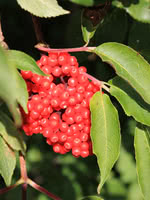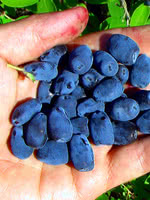Mon-Fri 9am - 5pm Mountain time
Red Elderberry vs Borealis Haskap (Honeyberry)
Sambucus racemosa
Lonicera caerulea Borealis
NOT AVAILABLE THIS SEASON - MIGHT RETURN
Red Elderberry is an attractive, medium-sized deciduous shrub.
It produces clusters of white flowers in the spring and bright red berry-like drupes, which provide beautiful contrast against its coarse, textured green foliage.
Red Elder can be pruned as a small single or multi-stemmed tree.
Borealis Haskap is a popular variety due to its great-tasting, sweet-tart berries. The flavour of Haskaps is generally described as a cross between a blueberry and a raspberry. Borealis Haskaps are well suited to fresh eating, baking, and preserves.
It has strong fruit holds and is not very firm so it does not do well when handled by equipment. This variety is a favourite for home gardens and U-Picks.
For optimal fruit production, cross-pollination is required. Haskaps need to be planted with a compatible variety. Compatibility is influenced by both bloom time and genetics.
Borealis Haskap is an early-pollinating variety and pairs well with Aurora and Honey Bee.
Red Elderberry Quick Facts
Borealis Haskap (Honeyberry) Quick Facts
Toxicity: toxic to humans

